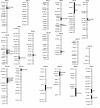Mapping quantitative trait loci for T lymphocyte subpopulations in peripheral blood in swine
- PMID: 21923905
- PMCID: PMC3182951
- DOI: 10.1186/1471-2156-12-79
Mapping quantitative trait loci for T lymphocyte subpopulations in peripheral blood in swine
Abstract
Background: Increased disease resistance through improved general immune capacity would be beneficial for the welfare and productivity of farm animals. T lymphocyte subpopulations in peripheral blood play an important role in immune capacity and disease resistance in animals. However, very little research to date has focused on quantitative trait loci (QTL) for T lymphocyte subpopulations in peripheral blood in swine.
Results: In the study, experimental animals consist of 446 piglets from three different breed populations. To identify QTL for T lymphocyte subpopulations in peripheral blood in swine, the proportions of CD4+, CD8+, CD4+CD8+, CD4+CD8-, CD4-CD8+, and CD4-CD8- T cells and the ratio of CD4+:CD8+ T cells were measured for all individuals before and after challenge with modified live CSF (classical swine fever) vaccine. Based on the combined data of individuals from three breed populations, genome-wide scanning of QTL for these traits was performed based on a variance component model, and the genome wide significance level for declaring QTL was determined via permutation tests as well as FDR (false discovery rate) correction. A total of 27 QTL (two for CD4+CD8+, one for CD4+CD8-, three for CD4-CD8+, two for CD4-CD8-, nine for CD4+, two for CD8+, and eight for CD4+:CD8+ ratio) were identified with significance level of FDR < 0.10, of which 11 were significant at the level of FDR < 0.05, including the five significant at FDR < 0.01.
Conclusions: Within these QTL regions, a number of known genes having potential relationships with the studied traits may serve as candidate genes for these traits. Our findings herein are helpful for identification of the causal genes underlying these immune-related trait and selection for immune capacity of individuals in swine breeding in the future.
Figures
Similar articles
-
Genome-wide association study for T lymphocyte subpopulations in swine.BMC Genomics. 2012 Sep 18;13:488. doi: 10.1186/1471-2164-13-488. BMC Genomics. 2012. PMID: 22985182 Free PMC article.
-
The kinetics of cytokine production and CD25 expression by porcine lymphocyte subpopulations following exposure to classical swine fever virus (CSFV).Vet Immunol Immunopathol. 2005 Jul 15;106(3-4):197-208. doi: 10.1016/j.vetimm.2005.02.017. Vet Immunol Immunopathol. 2005. PMID: 15963818
-
Mapping quantitative trait loci for cytokines in the pig.Anim Genet. 2011 Feb;42(1):1-5. doi: 10.1111/j.1365-2052.2010.02071.x. Anim Genet. 2011. PMID: 20477803
-
Detection of quantitative trait loci affecting haematological traits in swine via genome scanning.BMC Genet. 2010 Jun 28;11:56. doi: 10.1186/1471-2156-11-56. BMC Genet. 2010. PMID: 20584270 Free PMC article.
-
Extrathymic CD4/CD8 double positive T cells.Vet Immunol Immunopathol. 1999 Dec 15;72(1-2):55-66. doi: 10.1016/s0165-2427(99)00118-x. Vet Immunol Immunopathol. 1999. PMID: 10614493 Review.
Cited by
-
Genome-wide association study for T lymphocyte subpopulations in swine.BMC Genomics. 2012 Sep 18;13:488. doi: 10.1186/1471-2164-13-488. BMC Genomics. 2012. PMID: 22985182 Free PMC article.
-
Genome-wide association studies for 30 haematological and blood clinical-biochemical traits in Large White pigs reveal genomic regions affecting intermediate phenotypes.Sci Rep. 2019 May 7;9(1):7003. doi: 10.1038/s41598-019-43297-1. Sci Rep. 2019. PMID: 31065004 Free PMC article.
-
Genetic parameters and associated genomic regions for global immunocompetence and other health-related traits in pigs.Sci Rep. 2020 Oct 28;10(1):18462. doi: 10.1038/s41598-020-75417-7. Sci Rep. 2020. PMID: 33116177 Free PMC article.
-
Genome wide association study of thyroid hormone levels following challenge with porcine reproductive and respiratory syndrome virus.Front Genet. 2023 Feb 9;14:1110463. doi: 10.3389/fgene.2023.1110463. eCollection 2023. Front Genet. 2023. PMID: 36845393 Free PMC article.
-
Genome-wide association study for cytokines and immunoglobulin G in swine.PLoS One. 2013 Oct 2;8(10):e74846. doi: 10.1371/journal.pone.0074846. eCollection 2013. PLoS One. 2013. PMID: 24098351 Free PMC article.
References
-
- Wiseman J, Varley MA, Chadwick JP. Progress in Pig Science. Nottingham: Nottingham University Press; 1998. pp. 29–38.
-
- Visscher AH, Janss LLG, Niewold TA, De Greef KH. Disease incidence and immunological traits for the selection of healthy pigs. Vet Q. 2002;24:29–34. - PubMed
-
- Alving K. Airways vasodilatation in the immediate allergic reaction. Involvement of inflammatory mediators and sensory nerves. Acta Physiol Scand Suppl. 1991;597:1–64. - PubMed
Publication types
MeSH terms
LinkOut - more resources
Full Text Sources
Research Materials


